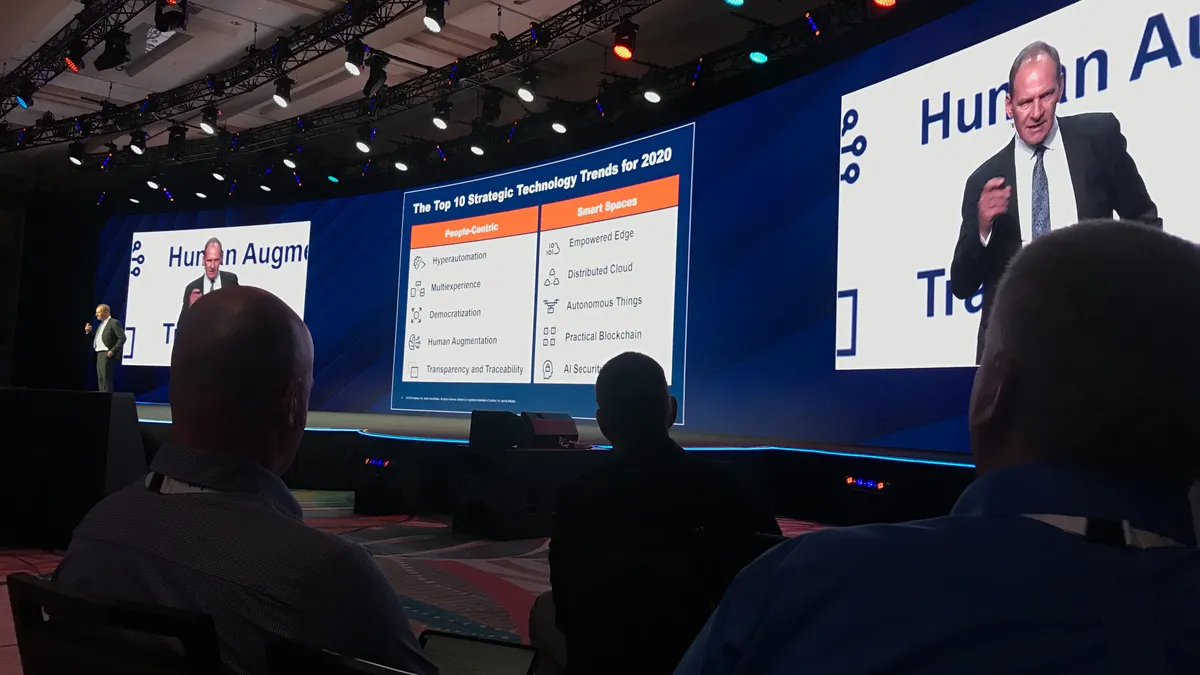Editor's note: CIO Dive split Gartner's top technology trends into two parts. The first focuses on technology interacting with people. Part 2, which highlights technology advancements that will make the world tick. Read it here.
In 1981, Douglas Adams introduced the world to a universal translator via human augmentation.
In "The Hitchhiker's Guide to the Galaxy," a bright yellow "Babel fish" is slipped into the hero Arthur Dent's ear to offer real-time translation from any language.
It's a concept popularized in science fiction, but advancements in technology are making similar capabilities possible in 2019, albeit less invasive. Microsoft Translator has live features, as does Google Assistant, which works in 27 languages.
Fictional and digital translation capabilities highlight where technology can go — the augmentation of human capabilities.
Technology trends are "really aggregating around people," said David Cearley, distinguished VP analyst at Gartner, speaking in October at the Gartner IT Symposium/Xpo in Orlando, Florida. Spaces are also becoming more intelligent and integrated, working to cognitively and physically enable humans.
IT helps everyone "understand and explore this complex world around us," he said.
In October, Gartner presented its top 10 strategic technology trends to look out for in 2020. Half focused on technology interacting with people. The rest broke down advancements that will make the world tick.
Here are the "people-centric" advancements IT decisions makers need to follow:
1. Hyperautomation
Simply put, hyperautomation's goal is "about automating everything we can automate," Cearley said.
Industry is centered on task automation, which includes rules and robotic process automation. As the technology and its adoption improves, industry will move toward process automation, managing overall workflows and introducing conversational UX to help automate process.
Once it advances to hyperautomation, organizations will move toward digital operations, which relies on introducing intelligence.
DigitalOps is looking at the business operations model, performance management and operational intelligence, according to Cearley. It's a feedback loop toward adding business value.
Read up:
- How to use RPA to increase back-office efficiency
-
Robots as a service: A low-risk path to warehouse automation?
-
2020 budget planning: Tech leaders prioritize efficiency, business outcomes
2. Multiexperience
The 2000s brought the widespread use of the web; the 2010s gave rise to mobile. Next up is a multiexperience generation.
Multiexperience is the shift from computer and a screen to incorporate multiple modes of input, such as voice, eye tracking or motion and gesture control, according to Cearley.
By 2021, Gartner projects one-third of enterprises will support "mobile, web, conversational and augmented reality development" through a multiexperience development platform. Such environments have multiple senses — conversational, immersive and sensory — and require serverless or event-driven technology.
Multiexperience technology will change how organizations train employees. Simulations already exist, but tapping into multiple senses will heighten the reality and make pilot training, for example, more effective.
Read up:
- Digital twins move from manufacturing and IoT into the back office
- All about 'Bertie': Overhauling CMS technology at Forbes
- Google updates enterprise-focused Google Glass after two years of experimentation
3. Democratization
Democratization movements have made technologies easier to use, lowering the bar to entry for advanced capabilities. Low- or no-code platforms allow almost anyone to build an app (after platform-specific training, of course).
It's focused on accessible technology with "accessible intelligence," weaving in virtual assistants or application automation, according to Cearley. Sales organizations could use predictive analytics to help identify high value leads.
When applied to AI, the lack of skills will become nullified as the tolls evolve. Further democratization means "shadow AI" could creep up across organizations, which could be a reality for 30% of organizations by 2022, according to Gartner.
Read up:
- Low code 101 and the rise of drag-and-drop programming
- AI talent demand dips as industry comes to terms with adoption
4. Human augmentation
This isn't quite the CRISPR technology hammering changes through the BioPharma space. The trend is all about "moving from designing for humans to architecting humans themselves," said Cearley. It includes smart prosthetics, smart contact lenses and RFID implants.
Cognitive automation will also emerge, training people and machines "to do their best," he said.
Gartner projects by 2025, 40% of enterprises will adopt human augmentation technologies and methodologies.
Read up:
- 3 lessons on the future of talent pipelines
- 2019's highest-paying IT certifications show power of the cloud
5. Transparency and traceability
With all the advancements in technology, a trust crisis is one the horizon — industry can blame unauditable AI, fake news and unauthorized data harvesting, among other concerns.
There's a lack of trust toward technology internally in organization and across society, said Cearley. "Aren't we all feeling this?"
The curb the environment of mistrust, by 2023, more than three-quarters of large organizations will tap AI specialists to "reduce brand and reputation risk," according to Gartner.
Their expertise will help reinforce six pillars of trust: integrity, ethics, openness, accountability, competence and consistency. They are principles for trust generally "but they certainly have implications in IT," said Cearley.




















